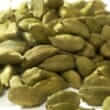Background
- Cardamom is the dried, unripened fruit of the perennial plant species Elettaria cardamomum. Enclosed in the fruit pods are tiny, brown, aromatic seeds, which are both pungent and sweet to the taste. Cardamom pods are generally green but are also available in a bleached white form. Cardamom is available both as a whole pod and as seeds that have had the outer hull removed.
- Several species in the Zingiberaceae (ginger) plant family are used like "true" cardamom. In general, species in the Aframomum genus are used as a spice. Elettaria species are used both as a spice and as medicine, and Amomum species are used as an ingredient in several traditional medicines in China, India, Korea, and Vietnam.
- Cardamom has been used traditionally to help digestion and relieve gas. It has also been used as a stimulant, breath freshener, and aphrodisiac.
References
Natural Standard developed the above evidence-based information based on a thorough systematic review of the available scientific articles. For comprehensive information about alternative and complementary therapies on the professional level, go to . Selected references are listed below.
- Achliya GS, Wadodkar SG, Dorle AK. Evaluation of sedative and anticonvulsant activities of Unmadnashak Ghrita. J Ethnopharmacol 2004;94(1):77-83.
View Abstract - Dhuley JN. Anti-oxidant effects of cinnamon (Cinnamomum verum) bark and greater cardamom (Amomum subulatum) seeds in rats fed high fat diet. Indian J Exp Biol 1999;37(3):238-242.
View Abstract - Elgayyar M, Draughon FA, Golden DA, et al. Antimicrobial activity of essential oils from plants against selected pathogenic and saprophytic microorganisms. J Food Prot 2001;64(7):1019-1024.
View Abstract - Gilani AH, Jabeen Q, Khan AU, et al. Gut modulatory, blood pressure lowering, diuretic and sedative activities of cardamom. J Ethnopharmacol 2008;115(3):463-472.
View Abstract - Huang YB, Fang JY, Hung CH, et al. Cyclic monoterpene extract from cardamom oil as a skin permeation enhancer for indomethacin: in vitro and in vivo studies. Biol Pharm Bull 1999;22(6):642-646.
View Abstract - Jafri MA, Farah, Javed K, et al. Evaluation of the gastric antiulcerogenic effect of large cardamom (fruits of Amomum subulatum Roxb). J Ethnopharmacol 2001;75(2-3):89-94.
View Abstract - Jamal A, Javed K, Aslam M, et al. Gastroprotective effect of cardamom, Elettaria cardamomum Maton. fruits in rats. J Ethnopharmacol 2006;103(2):149-153.
View Abstract - Kumar S. Panmasala chewing induces deterioration in oral health and its implications in carcinogenesis. Toxicol Mech Methods 2008;18(9):665-677.
View Abstract - Majdalawieh AF, Carr RI. In vitro investigation of the potential immunomodulatory and anti-cancer activities of black pepper (Piper nigrum) and cardamom (Elettaria cardamomum). J Med Food 2010;13(2):371-381.
View Abstract - Martins AP, Salgueiro L, Goncalves MJ, et al. Essential oil composition and antimicrobial activity of three Zingiberaceae from S.Tome e Principe. Planta Med 2001;67(6):580-584.
View Abstract - Sapra B, Gupta S, Tiwary AK. Role of volatile oil pretreatment and skin cholesterol on permeation of ion-paired diclofenac sodium. Indian J Exp Biol 2000;38(9):895-900.
View Abstract - Sengupta A, Ghosh S, Bhattacharjee S. Dietary cardamom inhibits the formation of azoxymethane-induced aberrant crypt foci in mice and reduces COX-2 and iNOS expression in the colon. Asian Pac J Cancer Prev 2005;6(2):118-122.
View Abstract - Suneetha WJ, Krishnakantha TP. Cardamom extract as inhibitor of human platelet aggregation. Phytother Res 2005;19(5):437-440.
View Abstract - Tayel AA, El Tras WF. Possibility of fighting food borne bacteria by egyptian folk medicinal herbs and spices extracts. J Egypt Public Health Assoc. 2009;84(1-2):21-32.
View Abstract - Vasudevan K, Vembar S, Veeraraghavan K, et al. Influence of intragastric perfusion of aqueous spice extracts on acid secretion in anesthetized albino rats. Indian J Gastroenterol 2000;19(2):53-56.
View Abstract







